Typhoid fever can leave you feeling weak and drained, but the recovery doesn’t have to be difficult. While medical treatment is essential, certain home remedies can help ease symptoms.
Typhoid is caused by a bacterial infection spread by contaminated water or food. It affects the intestinal tract and then spreads to the bloodstream. It is caused by the bacteria Salmonella typhi. Poor hygienic conditions, unsafe drinking water, and contaminated food are the usual causes of typhoid[1].
Here are 11 home remedies, from hydration tips to soothing foods, to help support your recovery along with your prescribed medications.
Friendly Reminder: The information shared here is for educational purposes only and the reader should consult a registered medical practitioner before implementing any changes to their health routine.
Complications may include

Typhoid fever may cause vomiting and diarrhoea that might lead to severe dehydration. To prevent dehydration, keep sipping on safe and healthy fluids[3]. Staying hydrated also helps in the timely elimination of waste materials and toxins from the body. Apart from water, have fruit juices, coconut water, and soups.
ORS is the best solution to combat the dehydration caused by typhoid fever. Ensure that you have WHO-recommended ORS. You can even make it at home by mixing sugar and salt in a litre of boiled water.

To combat high fever, sponging with lukewarm water can help reduce the temperature and be a supportive method in addition to fever-lowering medicines like paracetamol. You can sponge off armpits, feet, groin, and hands. Sponging on the extremities brings down the fever most effectively.
You can also soak a washcloth in water, squeeze out the excess water and place it on your forehead. Change the washcloth frequently.
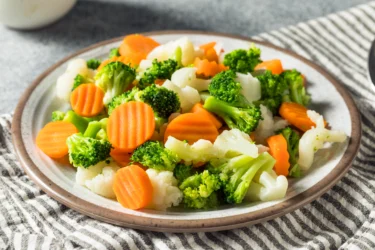
Consume easy-to-digest foods[6]. Cut down on fried and spicy foods. Avoid raw salad and fruits that cannot be peeled. You should consult your doctor about the meal plan depending on your condition.
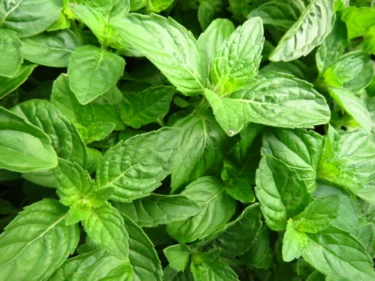
Basil is loaded with antibiotic and antimicrobial properties. Add basil to boiled water and drink three to four cups daily. Basil boosts immunity and calms the tummy[7].
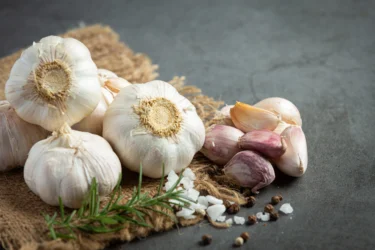
The antimicrobial properties present in garlic may speed up the recovery from typhoid due to its antioxidative properties [5].

Bananas have pectin, a soluble fibre that helps the intestines absorb fluids, thus beneficial during diarrhoea. Potassium in the fruit helps in replacing the electrolytes lost through loose motions. It is one of the best things to eat when having typhoid[9].
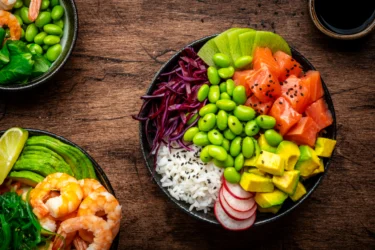
Consume small amounts of easy-to-digest food at frequent intervals.
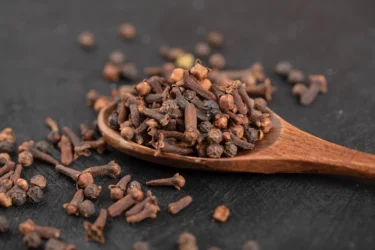
Cloves fight against bacteria that cause typhoid. The essential oils in cloves have antibacterial properties. It also reduces nausea and vomiting caused by typhoid. Boil water with cloves, strain in a cup and have a small amount of it[7].
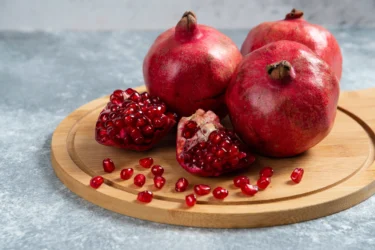
Pomegranates are an effective home remedy against typhoid. It helps in preventing dehydration. Have it as pomegranate juice for the ease of digestion[8].

Buttermilk is loaded with probiotics which not only improves gut health but also helps support the immune system. Additionally, it helps to break proteins down, which can aid in the recovery process after your fever has passed. This is one of the home remedies for typhoid that you should use towards the end of your fever.

Typhoid fever is often associated with weakness and fatigue. It is vital to take adequate rest to support recovery.
Consult a doctor and use the home remedies for a speedy recovery. With proper rest, light food, clean water, and prescribed medicines, the patients usually recover well.
Also Read: Typhoid Vaccine: What is It, Types, When to Be Taken & Side Effects
Also Read: Influenza B: What is It, Causes, Symptoms, Treatment & Prevention
Recovering from typhoid takes time, a lot of care, and the right approach. These simple home remedies along with your medical treatment can help you feel better faster. Every small effort counts, whether it’s staying hydrated, eating nutrient-rich foods, or getting enough rest. Always consult a doctor before trying new remedies.
Also Read: Home Remedies for Jaundice By Dr. Siddharth Gupta
Foods that should be avoided by someone suffering from typhoid fever are raw vegetables like broccoli, cauliflower, cabbage, dry fruits,raw berries, pineapple, nuts like almonds, pistachios, walnuts and seeds like pumpkin seeds, flax seeds, chia seeds.
In order to prevent typhoid fever you must drink clean water, keep your surroundings clean and practise good hygiene like wash your hands frequently[1], use alcohol-based sanitizers, avoid drinking untreated water, clean raw fruits and vegetables[1], eat hot foods and get vaccinated.
With proper treatment, the symptoms of typhoid fever should improve within 3-5 days but recovery can take around 1-2 weeks. The course of prescribed medicines should not be discontinued in between. If typhoid fever isn’t treated, it can get worse and there is a significant risk of life-threatening complications.
Disclaimer: The information provided here is for educational/awareness purposes only and is not intended to be a substitute for medical treatment by a healthcare professional and should not be relied upon to diagnose or treat any medical condition. The reader should consult a registered medical practitioner to determine the appropriateness of the information and before consuming any medication. PharmEasy does not provide any guarantee or warranty (express or implied) regarding the accuracy, adequacy, completeness, legality, reliability or usefulness of the information; and disclaims any liability arising thereof.
Typhoid is a bacterial infection caused by Salmonella typhi, a bacterium. It is typically characterised by high fever, nausea, vomiting, and, in some cases, diarrhoea. The disease is primarily transmitted through the consumption of food or water contaminated with faecal matter, making it more common in areas with inadequate sanitation and limited access to clean drinking water. If left untreated, typhoid can be fatal. However, with timely diagnosis and appropriate antibiotic treatment, most individuals make a full recovery. Improving hygiene and sanitation practices is key to preventing the spread of this potentially life-threatening illness..
Other serious complications include1:
Common and more specific complications of typhoid include1:
In many cases, individuals may carry Salmonella typhi without showing any noticeable symptoms, a condition known as being an asymptomatic carrier. These carriers can unknowingly contribute to the spread of the infection. Once symptoms become evident, such as persistent fever and gastrointestinal discomfort, a course of antibiotics is typically prescribed to manage the infection and help recovery2.
In addition to antibiotic treatment, individuals diagnosed with typhoid are often advised to stay well-hydrated by consuming clean, preferably boiled water, and to practise strict food hygiene, such as thoroughly washing fruits and vegetables before consumption2.
During pregnancy, typhoid can lead to serious complications, including miscarriage, premature labour, intrauterine growth restriction (IUGR), and even faetal loss, largely due to systemic infection and high maternal fever3. Vaccination offers a significant degree of protection and is especially recommended for those living in or travelling to areas where typhoid is endemic. However, as no vaccine provides complete immunity, it must be complemented by good sanitation and hygiene practices to effectively prevent infection and limit its spread4.
If an individual has not been exposed to the Salmonella typhi bacterium, typhoid vaccination is often recommended as a preventive measure. Doctors may prescribe the vaccine to those who are carriers of the disease, individuals in close contact with typhoid patients, or persons planning to travel to regions where typhoid fever is prevalent. The vaccine is available in two forms: an oral capsule (Ty21a) or a single-dose injection (Vi polysaccharide). However, the vaccine is preventive rather than therapeutic, meaning it does not treat active infections and is ineffective once illness has begun. It is also not suitable for very young children. The polysaccharide vaccine is approved for children aged two years and above, while the oral Ty21a vaccine is approved for those aged six years and older. In rare cases, the vaccine may cause mild side effects, including gastrointestinal discomfort, headache, or nausea, and should therefore be administered under medical supervision2.
Typhoid fever is an illness you get from S. Typhi bacterium. It causes a high fever, flu-like symptoms, and diarrhoea. You can be contagious with typhoid even if you don’t feel sick. Typhoid can be life-threatening and is usually treated promptly with antibiotics.
Dr. M.G. Kartheeka, MBBS, MD(Pediatrics)
To reduce the risk of contracting Salmonella typhi, it is advisable to follow these preventive practices, especially when travelling to or living in areas where typhoid is common5:
To minimise the risk of contracting or spreading typhoid, it is important to follow these essential personal hygiene practices6:
Typhoid is a serious but preventable bacterial infection that spreads through contaminated food and water. Maintaining good hygiene, following safe food and water practices, and considering vaccination where appropriate are key to prevention. With prompt medical attention and responsible habits, the risks associated with typhoid can be significantly reduced.
Also Read: Typhoid Vaccine: What is It, Types, When to Be Taken & Side Effects
Disclaimer: The information provided here is for educational/awareness purposes only and is not intended to be a substitute for medical treatment by a healthcare professional and should not be relied upon to diagnose or treat any medical condition. The reader should consult a registered medical practitioner to determine the appropriateness of the information and before consuming any medication. PharmEasy does not provide any guarantee or warranty (express or implied) regarding the accuracy, adequacy, completeness, legality, reliability or usefulness of the information; and disclaims any liability arising thereof.